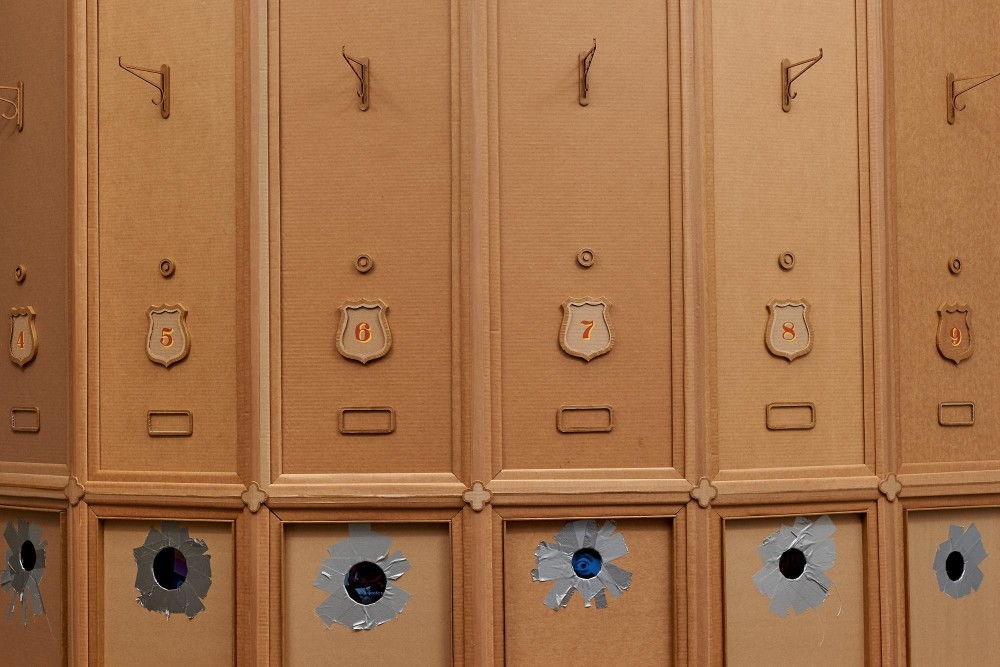
Yuval Pudik The Hom(o)stead Act: Kaiserpanorama
Adjectives that take their name from authors only ever sum up a narrow slice of their writing. Describe something as “kafkaesque” and the immediate picture it conjures will be of bureaucratic anxiety and general weirdness; a surreal and frustrating trip through the DMV offices of the mind. But Franz Kafka had a life outside of his family firm and it was just as crucial to his way of viewing the world. Along with his friend (and literary executor) Max Brod, Kafka regularly went to the cinema, peering through a small aperture to see people materialize onto the screen and vanish just as suddenly into the ether. The perspective that he developed - which would go on to define so much of what it meant to be modern - had as much to do with gazing head-long into the darkness as it did with circus lights, camera flashes, and the faint, silvery glow of the movies.
Yuval Pudik’s debut show at NOON Projects, The Hom(o)stead Act: Kaiserpanorama is both a fully functional theater of the kind that Kafka would frequent, and a time machine that processes the raw stuff of the present. The artist is acutely aware of how the spectral shapes that Kafka saw have not only leaped out of the frame but subsumed our reality. We’re no longer in the post-modern dilemma of all having seen this (and every) movie before; now we’re tasked with sussing out if the undifferentiated slop on our plate is art or advertising, AI or life. Pudik’s solution to grappling with our moment is to take the overflow of imagery and play it back through a distinctly queer lens. By resurrecting the Kaiserpanorama, the artist takes an obsolete form of cinema and turns it into a portal for queer sensibility.
The original Kaiserpanorama was a ring of elaborately carved wooden cabinets with a small viewfinder to peer into. Pudik’s by contrast is a series of cardboard panels interspersed with elegantly carved glory holes. Approach it and immediately be taken in by the glamour of fine craftsmanship and the unmistakable smuttiness of tea-room trade. With mind-boggling labor and skill, Pudik’s work elevates a cheap material into a luxury product and brings into focus the role that desire plays in looking. If you want to see what’s going on inside Pudik’s show, you’ll have to own up to it and put your eyes where your mouth is.
Peek through the opening though and the viewer will find themself level with a video collage that plays like a super-cut of contemporary culture. The movie within is an unrelenting stream of content that encompasses everything from high-brow arts programming to a brain-rotted call-and-response between Donald Trump and Trisha Paytas. The pace of the film is hysterical and Pudik’s eye as an editor is trained on teasing out funny synchronicities and flare-ups of accidental camp. In a roundabout way, the artist suggests that the iPhone he used to source this footage is something like the Kaiserpanorama’s opposite: a narrow gateway to the enormity of the Internet that spills out and overwhelms our reality. By taking his archive of images sourced from his phone and projecting them into his work, Pudik redirects the flow of content and holds it in theatrical relief.
In the third phase of the installation, the central cavity at the heart of the installation will play host to a number of events, including a tattoo-ing session by Joshua Rains and a screening of a film by Steven Arnold (co-hosted with Del Vaz Projects). Only accessible via crawling on hands and knees, this open area is strung with tinsel, collaged over with thousands of images, and littered about with art and ephemera that evoke regional gay bars. It could not be more of a queer space if it tried. These interventions will be a jolt of real life to the illusory madness of the film, people actually acting, engaging, and responding to one another in real time. Like the machine’s multiple stations (and gloryholes) suggest, the artist’s work is a group undertaking, meant to be experienced with others. Despite his remarkable hand as a creator, Pudik’s perspective is purposefully de-centered. With his Kaiserpanorama, he gathers his audience around to take in the chaos of the wider world in the hope that we’ll be able make sense of it together.
–Harry Tafoya